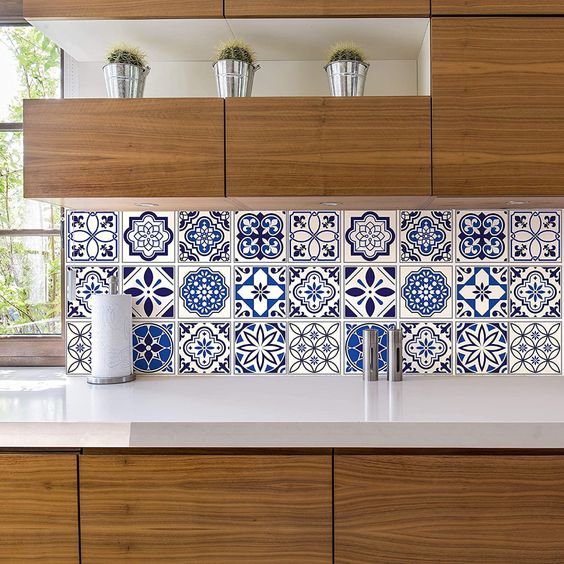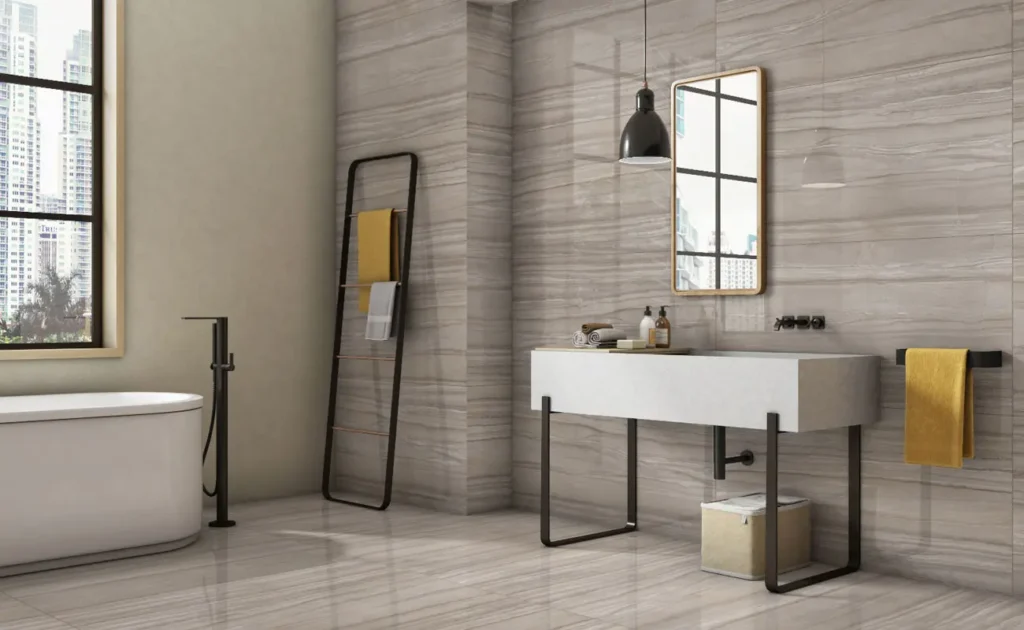600×1200 Bathroom Tiles 2×4 Tiles.
Debunking the Debate: 600×1200 Bathroom Tiles 2×4 Tiles. Discover the perfect floor tile size for your dream bathroom remodel, with expert tips on aesthetics, installation, and budget!
Introduction
The heart of any bathroom lies in its functionality and aesthetics. But let’s face it, achieving that perfect balance often starts with the foundation – the floor tiles. And when it comes to selecting the right size, two options reign supreme: the classic 2×4 tiles (12″ x 24″) and the modern marvel, the 600x1200mm tile (approximately 23.6″ x 47.2″).
This blog post is your one-stop guide to navigating the great bathroom tile size debate. We’ll delve into the pros and cons of both options, explore their impact on design, installation, and budget, and ultimately help you choose the perfect fit for your dream bathroom.
Understanding the Tile Sizes
- 2×4 Tiles (12″ x 24″) – This industry standard has been a popular choice for decades. Its manageable size makes cutting and installation easier for DIY enthusiasts and professionals alike.
- 600x1200mm Tiles (23.6″ x 47.2″) – Also known as large format tiles (LFTs), these modern beauties are making a splash in bathroom renovations. Their sleek size creates a seamless, expansive look, ideal for contemporary spaces.

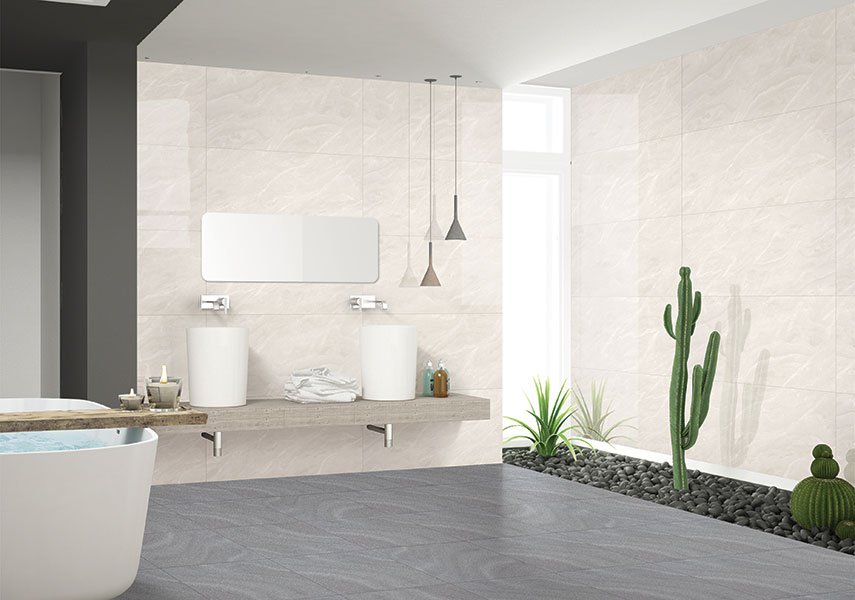





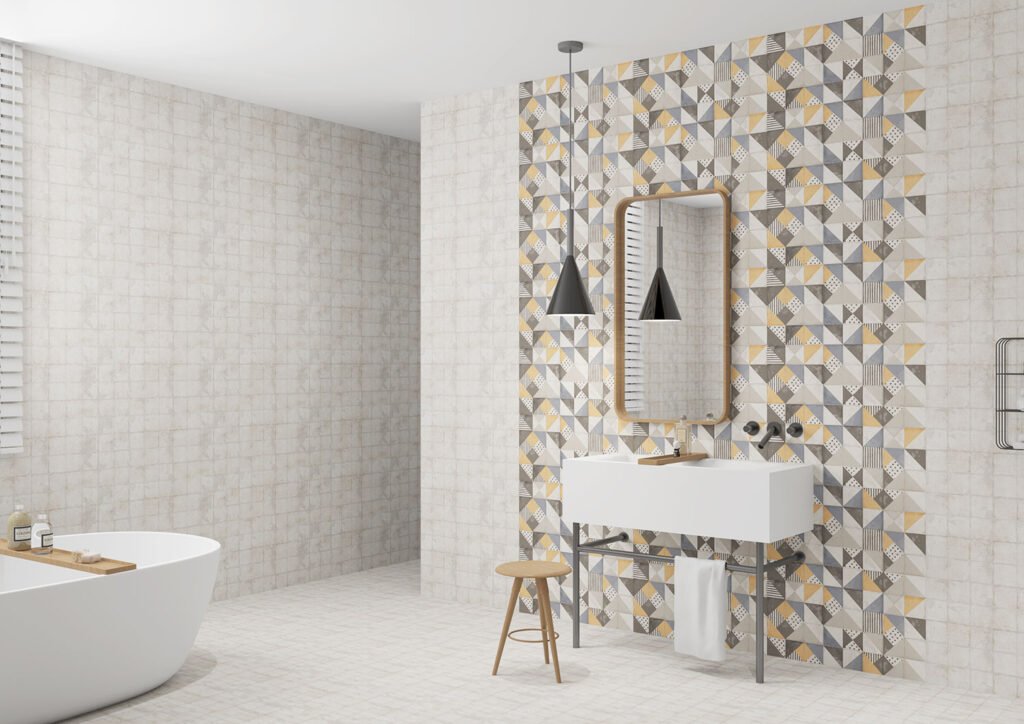
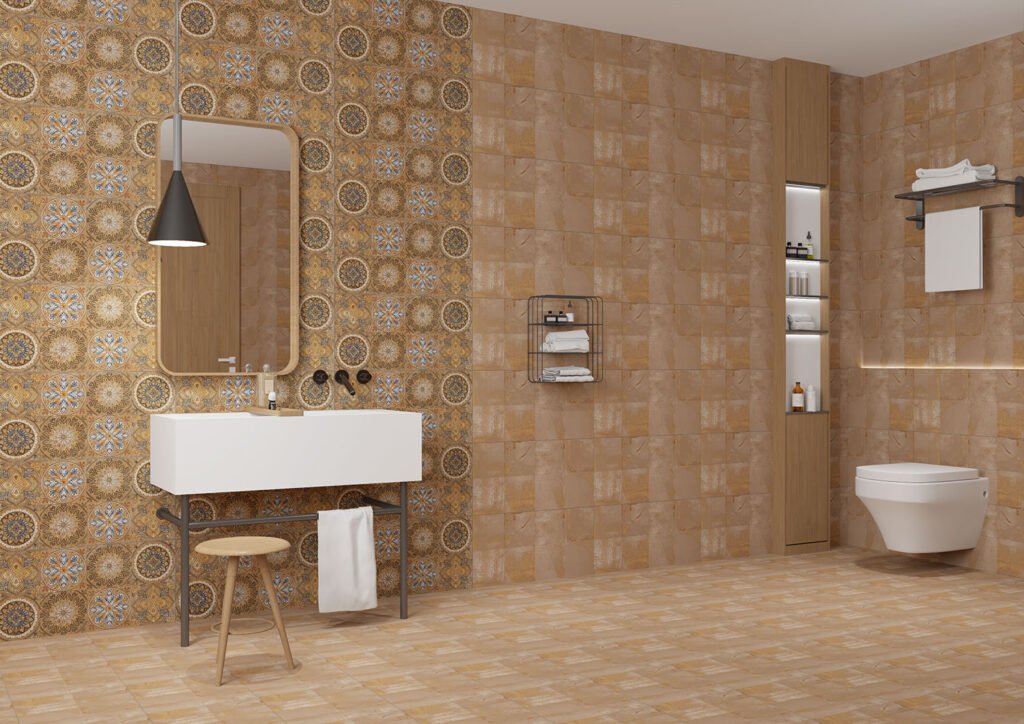
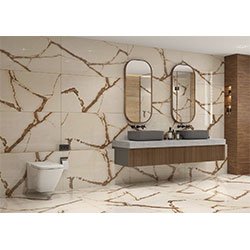




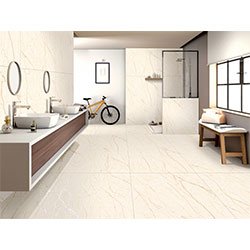
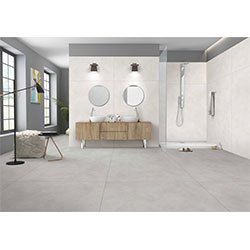

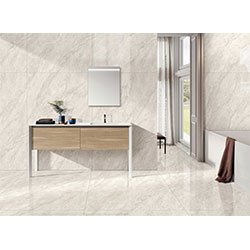
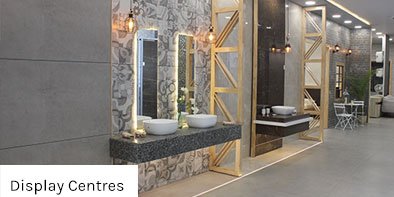
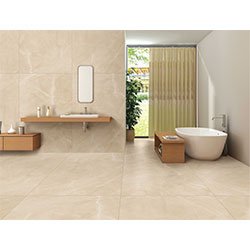
The Aesthetic Showdown: 600×1200 vs. 2×4
The Allure of Large Format Tiles (600x1200mm)
- Minimal Grout Lines: LFTs boast fewer grout lines, creating a visually uninterrupted, luxurious feel. This is especially beneficial for showcasing stunning stone or high-patterned tiles.
- Modern & Spacious Effect: The larger canvas allows for a more open and airy ambience, particularly valuable in smaller bathrooms.
- Versatility in Design: LFTs can be laid in a variety of patterns, like vertical stacks or a staggered herringbone, for a dramatic impact.
The Enduring Charm of 2×4 Tiles
- Classic & Timeless: 2×4 tiles offer a familiar and elegant aesthetic that complements various bathroom styles, from traditional to transitional.
- Detailed Patterns & Mosaics: Their smaller size allows for intricate patterns and mosaic designs, adding a touch of personality to your bathroom floor.
- Easier Cutting & Installation: The smaller size makes them easier to cut for custom layouts and around fixtures, potentially reducing installation waste.
Balancing Design with Practicality
Considering the Grout Factor: While minimal grout lines on LFTs are aesthetically pleasing, they require extra attention during cleaning to prevent dirt and mildew buildup.
Subfloor Preparation: Uneven floors might require significant subfloor work for LFT installations, potentially impacting your budget.
Shower Pan Compatibility: LFTs may not always be readily available for shower pan applications. Consult with your contractor to ensure compatibility before finalizing your choice.
The Installation Equation
2×4 Tiles: Installation of 2×4 tiles is generally faster and less labor-intensive due to their manageable size. This can translate to lower installation costs for DIY enthusiasts and professionals alike.
600x1200mm Tiles: The larger size of LFTs makes them heavier and requires skilled labor for handling and installation. This can translate to higher installation costs.
Budgeting for Your Dream Bathroom
2×4 Tiles: Typically, 2×4 tiles are a more budget-friendly option due to their lower material and installation costs.
600x1200mm Tiles: While LFTs can be more expensive per square foot, the fewer tiles needed may offset the cost somewhat. However, installation costs play a significant role, so factor that into your budget considerations.
The Final Verdict: It’s All About You!
There’s no single “best” choice when it comes to tile size. It all boils down to your bathroom’s specific needs, design preferences, and budget.
Here are some key takeaways to guide you:
- Go for LFTs if: You prioritize a modern, expansive aesthetic, minimal grout lines, and have a larger bathroom budget.
- Choose 2×4 tiles if: You prefer a classic look, enjoy intricate patterns, have a smaller bathroom, or are working with a tighter budget.
Frequently Asked Questions (FAQs) on 600×1200 Bathroom Tiles vs. 2×4 Tiles
1. Are 600x1200mm tiles too big for a small bathroom?
Not necessarily! While large format tiles can create an illusion of spaciousness, proper design plays a crucial role. Using lighter colors and reflective finishes can enhance the feeling of openness in a smaller bathroom.
2. Do I need a professional to install 600x1200mm tiles?
Due to their weight and size, professional installation is highly recommended for LFTs. Skilled contractors can ensure proper handling, subfloor preparation, and a seamless finish.
3. Can I use 600x1200mm tiles for my shower pan?
While some manufacturers offer LFTs specifically designed for shower pans, availability may be limited. Discuss options with your contractor to find the best fit for your shower application.
4. Are 2×4 tiles outdated?
Absolutely not! 2×4 tiles remain a classic and versatile choice, offering timeless elegance and a wide variety of design possibilities. Their smaller size makes them ideal for intricate patterns and mosaic designs, adding a unique touch to your bathroom.
5. How do I choose the right grout color for my bathroom tiles?
For a seamless look with LFTs, consider grout that matches the color of your tiles. For a more defined look with 2×4 tiles, you can choose a contrasting grout color. Consider factors like the overall color scheme, desired level of contrast, and ease of maintenance when selecting your grout color.
6. What are some popular materials for bathroom floor tiles?
Ceramic and porcelain tiles are the most popular choices for bathroom floors due to their durability, water resistance, and ease of maintenance. Natural stone tiles like marble or granite offer a luxurious look but require special care and can be more susceptible to water damage.
7. How do I ensure my bathroom floor tiles are slip-resistant?
Look for tiles with a textured or matte finish, which provide better traction and reduce the risk of slipping. Many manufacturers offer tiles specifically designed for bathroom applications with slip-resistant properties.
8. How often should I clean and seal my bathroom floor tiles?
Regular cleaning with a mild detergent is essential. The frequency of sealing depends on the material of your tiles. Consult the manufacturer’s recommendations for specific cleaning and sealing guidelines.
9. What are some creative ways to lay bathroom floor tiles?
For 2×4 tiles, experiment with brickwork patterns, herringbone layouts, or even basketweave designs for a touch of personality. With LFTs, explore vertical stacking, a staggered herringbone, or even a windmill pattern for a dramatic visual effect.
10. How can I make my bathroom floor tiles look more expensive?
- Choose tiles with a subtle shimmer or metallic accents for a touch of luxury.
- Opt for larger format tiles, which create a more sophisticated look.
- Consider high-quality grout that complements your tiles for a polished finish.
- Use a rectified tile, which has precisely squared edges, allowing for minimal grout lines and a seamless appearance.
By understanding the pros and cons of both 600x1200mm and 2×4 tiles, along with the valuable insights from these FAQs, you’re well-equipped to make an informed decision that elevates your bathroom design and reflects your unique style.
Frequently Asked Questions (FAQs) on 600×1200 Bathroom Tiles vs. 2×4 Tiles
1. Are 600x1200mm tiles too big for my small bathroom?
Not necessarily! While LFTs can create a more open feel, smaller bathrooms can still benefit from their minimal grout lines. However, consider the layout. If your bathroom has many nooks and crannies, cutting and installing LFTs might be challenging.
2. Can I install 600x1200mm tiles myself?
While some experienced DIYers might attempt it, LFTs are generally recommended for professional installation due to their weight and handling requirements. Improper installation can lead to costly repairs down the line.
3. Are there different thicknesses for these tiles?
Yes, both 2×4 and 600x1200mm tiles come in various thicknesses. For bathroom floors, choose a minimum thickness of 8mm for optimal durability.
4. Do LFTs require special tools for cutting?
Yes, cutting LFTs requires specialized wet saws for clean and precise cuts. Standard tile cutters might not be strong enough for these large tiles.
5. Are there any limitations on the type of material for LFTs?
While LFTs are available in various materials like ceramic, porcelain, and natural stone, some materials, particularly natural stone, might be more prone to cracking during installation due to their larger size.
6. Can I mix and match 2×4 and 600x1200mm tiles in my bathroom?
Yes, you can! This can be a creative way to achieve a unique look. However, ensure the thickness of both tiles is compatible for a seamless transition.
7. How do I choose the right grout color for my bathroom tiles?
For a clean and modern look, consider grout that matches the color of your tiles. Conversely, a contrasting grout color can highlight the individual tiles and create a more defined pattern.
8. What are some tips for maintaining the grout in my bathroom?
Seal your grout after installation to prevent staining and mold growth. Regularly clean your grout with a grout cleaner or a mixture of vinegar and water.
9. Should I consider textured bathroom floor tiles?
Textured tiles can add visual interest and provide a slip-resistant surface, especially important for shower areas. However, textured tiles might be more challenging to clean.
10. How long will my bathroom tile floor last?
With proper care and maintenance, high-quality bathroom floor tiles, both 2×4 and 600x1200mm, can last for decades.
Conclusion
Choosing the perfect bathroom floor tile size is an exciting step in your renovation journey. By understanding the unique advantages and considerations of both 600x1200mm and 2×4 tiles, you can make an informed decision that complements your design vision and fits your budget. Remember, don’t hesitate to consult with a professional designer or contractor to discuss your specific needs and explore all the possibilities!
Some mote Frequently Asked Questions (FAQs) on 600×1200 Bathroom Tiles vs. 2×4 Tiles
1. Are 600x1200mm tiles too big for a small bathroom?
Not necessarily! While large format tiles can create an illusion of spaciousness, proper design plays a crucial role. Using lighter colors and reflective finishes can enhance the feeling of openness in a smaller bathroom.
2. Do I need a professional to install 600x1200mm tiles?
Due to their weight and size, professional installation is highly recommended for LFTs. Skilled contractors can ensure proper handling, subfloor preparation, and a seamless finish.
3. Can I use 600x1200mm tiles for my shower pan?
While some manufacturers offer LFTs specifically designed for shower pans, availability may be limited. Discuss options with your contractor to find the best fit for your shower application.
4. Are 2×4 tiles outdated?
Absolutely not! 2×4 tiles remain a classic and versatile choice, offering timeless elegance and a wide variety of design possibilities. Their smaller size makes them ideal for intricate patterns and mosaic designs, adding a unique touch to your bathroom.
5. How do I choose the right grout color for my bathroom tiles?
For a seamless look with LFTs, consider grout that matches the color of your tiles. For a more defined look with 2×4 tiles, you can choose a contrasting grout color. Consider factors like the overall color scheme, desired level of contrast, and ease of maintenance when selecting your grout color.
6. What are some popular materials for bathroom floor tiles?
Ceramic and porcelain tiles are the most popular choices for bathroom floors due to their durability, water resistance, and ease of maintenance. Natural stone tiles like marble or granite offer a luxurious look but require special care and can be more susceptible to water damage.
7. How do I ensure my bathroom floor tiles are slip-resistant?
Look for tiles with a textured or matte finish, which provide better traction and reduce the risk of slipping. Many manufacturers offer tiles specifically designed for bathroom applications with slip-resistant properties.
8. How often should I clean and seal my bathroom floor tiles?
Regular cleaning with a mild detergent is essential. The frequency of sealing depends on the material of your tiles. Consult the manufacturer’s recommendations for specific cleaning and sealing guidelines.
9. What are some creative ways to lay bathroom floor tiles?
For 2×4 tiles, experiment with brickwork patterns, herringbone layouts, or even basketweave designs for a touch of personality. With LFTs, explore vertical stacking, a staggered herringbone, or even a windmill pattern for a dramatic visual effect.
10. How can I make my bathroom floor tiles look more expensive?
- Choose tiles with a subtle shimmer or metallic accents for a touch of luxury.
- Opt for larger format tiles, which create a more sophisticated look.
- Consider high-quality grout that complements your tiles for a polished finish.
- Use a rectified tile, which has precisely squared edges, allowing for minimal grout lines and a seamless appearance.
By understanding the pros and cons of both 600x1200mm and 2×4 tiles, along with the valuable insights from these FAQs, you’re well-equipped to make an informed decision that elevates your bathroom design and reflects your unique style.
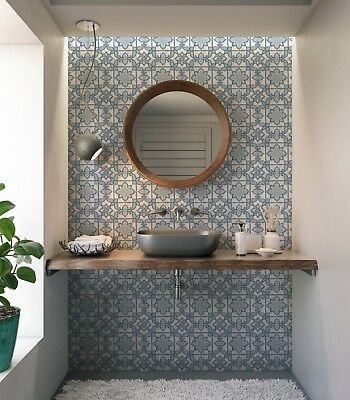
See Also : Morrocan bathroom Tiles Designs
